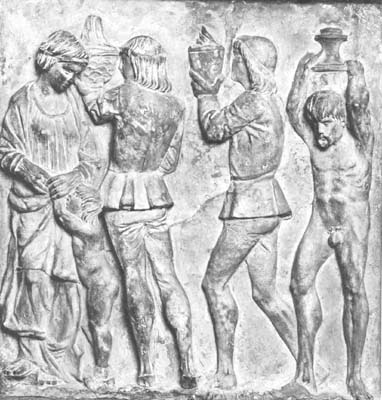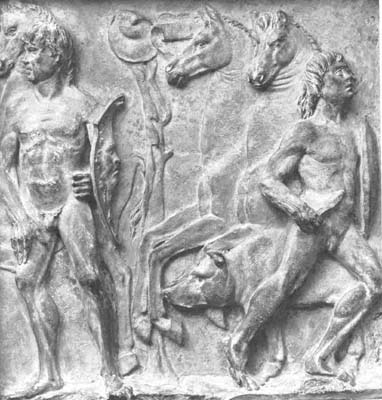
Bulletin 14, 1969
Home
Français
Introduction
History
Annual Index
Author &
Subject
Credits
Contact


Two
Lombard Decorative Reliefs
by Ulrich Middeldorf
Résumé en français
Pages 1 | 2
What a contrast there is between the towns on the hills and in
the valleys of central Italy and those in the plains north of the
Apennines. Narrow streets, skimpy squares, austere, almost grill
buildings in the former; large avenues, spacious squares, often surrounded by arcades, and splendidly grouped and decorated buildings
in the latter. Here a strong rationality and economy, there a gay,
even luxurious display. This difference in style of life is most
clearly reflected in the dwellings of the leading families. We are
used to thinking of the Renaissance palaces in terms of the Palazzo
Medici, the Palazzo Strozzi and others like them in Florence, and
may forget that their sober, classical facades find their perfect
match in the highly decorated, often colourful facades of the palaces of Bologna, Ferrara, Cremona and other towns in Emila, Lombardy
and the Veneto.
In the Po valley good building stone was less easily available than
in central Italy. Hence brick and its decorative counterpart,
moulded or modelled terracotta, have here been more generally
employed for buildings than in any other parts of Italy. A
particular type of brick architecture was developed here, beginning
during or even before the Romanesque period, which found one of its
high points in some Lombard palaces of the 15th century. The
National Gallery of Canada has been fortunate in acquiring two
decorative fragments which probably come from one of the most
famous and most sumptuous of them, the Palazzo Fodri in Cremona
(figs. 1, 2). (1)
Terracotta decorations in building were nothing new in the
Mediterranean and Near Eastern area. Ever since Babylonian times
they were used; they were popular with the Greeks, the Etruscans,
the Romans. When the old practice was later taken up again, it was
in a different context and with different intentions. And yet some
gossamer thread connects our two reliefs with the old classical
tradition.
In 1490, Benedetto Fodri, a member of an ancient patrician family of
Cremona, concluded a contract with the architect Guglielmo da Bocoli
(called De Lera) for a complete rebuilding and redecoration of his
house. Previously he had contracted with two stonemasons, Giovanni
Pietro da Rho and Nicolao da Porleggia (or Porlezza) from Brescia
for the furnishing of decorative marble work. In 1493, Alberto
Maffiolo from Carrara received the commission for the splendid
marble doorway on the facade. The building remained in the family
till 1578, when it was sold to the convent of Santa Marta in
Valverde. It underwent various other changes, among which apparently
were some unfortunate restorations which may have substantially
changed its character. That of 1930, which was undertaken by order
of the present owner, the Cassa di Risparmio, has established its
present aspect. (2)
The confused history and the uncertain condition of the building are
worth mentioning for a number of reasons. In the process of
restoration some pieces of the decoration may have been discarded or
replaced. In this fashion our two pieces may have found their way
into the antiquarian market. On the other hand, here is an
opportunity to clear up a long-standing case of serious
misinformation. Everywhere publications have presented an interior
facade of a Palazzo Stanga in Cremona - not the one from which the
Louvre acquired the famous doorway - as the epitome of Lombard
terracotta architecture of this period; and this facade shows the
same decorative reliefs as the Palazzo Fodri. Consequently these
reliefs are frequently published as belonging to this Palazzo
Stanga. According to reliable information, however, this facade is a
romantic reconstruction, partly in stucco, in which use was made of
the motifs, or perhaps even of actual fragments, of the terracotta
decoration of the Palazzo Fodri. (3)
Our reliefs correspond to individual sections of a 2.62-metre-long
frieze (103 1/8 in.) which is repeated along one side of the court
yard of the Palazzo Fodri between the arcades and the upper loggia
(fig. 5) and which is continued on two other sides by the repetition of another similar
scene (figs. 3, 4). (4) In the frieze
culminates the whole decorative scheme of the courtyard, with its
columns and decorated pilasters, its elegant capitals all of stone,
the richly decorated terracotta mouldings and a narrower, figured
frieze under the eaves. We have to imagine the whole discreetly
tinted, with perhaps a blue background, and enriched with a great
deal of gilding.
What does the frieze represent? Certainly, it has an obvious
resemblance to Roman sarcophagi or Roman mythological or historical
reliefs. We see a
mêlée
of nude warriors, and at the right Jupiter
on a chariot: classical motifs indeed. The frieze under the eaves
depicts the triumph of Bacchus. (5) But these classical elements do
not make sense, and, surprisingly enough, a few contemporary figures
mingle with the pagan ones (fig. I). Whereas in Tuscany such a
decoration would be made to express a carefully elaborated, of tell
obscure program, which would require that each section of a frieze
should contain a specific episode - witness the friezes of the Villa
of Poggio a Caiano and that of the house of Bartolomeo Scala in
Florence (6) - here one and the same motif is repeated till the
available space is filled. Obviously there cannot be any deeper
meaning. The friezes have a purely decorative function, and are only
meant to give a general classical flavour to the architecture. This
is quite in accordance with the difference between the two regions
of Italy hinted at in the beginning.
The trickiest problem connected with the two reliefs is that of
attribution. Neither the stonemasons who furnished decorative marble
work nor Alberto Maffiolo, who made the marble portal, can be held responsible
for the terracotta decoration. Two specialists in terracotta
who were active in Cremona, Rinaldo de Stauris and Agostino de
Fondulis, have been suggested, but without any conviction. (7) The
same is true for Pietro da Rho. (8) It is not even said that these
decorative friezes are specifically Cremonese. The Museum of the
Castello Sforzesco in Milan owns a set of fragments of an identical
frieze; and those were found in Milan, at the demolition of a house
in Via Vittorio Emanuele. (9) It is a fact that the Lombard sculptors
of this period moved easily from place to place; moreover,
terracotta plaques were easily shipped. The exact relation between
our reliefs and those in Milan could only be established by a
careful comparison of their measurements, not only overall, but also
of specific parts. Such a comparison would tell us whether one set
might have been copied from the other or whether both were taken
from the same mould.
To the unbiased eye, the artistic character and quality are clear.
The elegant young men in their tight- fitting clothes and with
their sharp angular movements in one of our reliefs find their
prototypes in the work of Amadeo, the leading sculptor of the period
in Milan and Pavia. The best parallel is even available locally, in
the reliefs of a
chasse
for some martyrs (formerly in the monastery
of San Lorenzo, and today incorporated in two pulpits of the
Cathedral of Cremona), which Amadeo signed and dated in 1482. (10)
Here we find the same sharply cut faces, framed by long hair falling
in a large wave over the shoulders and back. Not that the reliefs of
the Palazzo Fodri could be directly attributed to Amadeo; their
author must have been one of the sculptors who gathered around him
and created a general fashion from his style. Many of them are even
known by name, but unfortunately the whole group has thus far been
so little studied that identification of any one of them as the
author of our reliefs is still impossible. Thus it may suffice if we
conclude that we have here two beautiful and typical examples of the
Lombard school of Renaissance sculpture whose achievements, though
differing in kind, rival those of the better known contemporary
sculptors of Venice and Tuscany. (11)
Next Page | Notes
1 | 2
Annual Index | Author & Subject | Credits | Contact
This digital collection
was produced under contract to Canada's Digital Collections program,
Industry Canada.
"Digital
Collections Program, Copyright
© National Gallery of
Canada 2001"